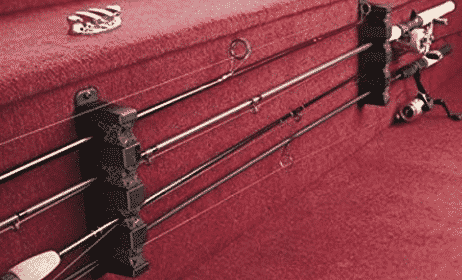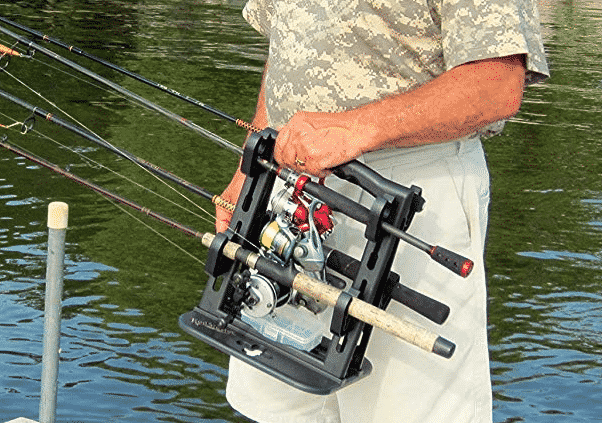Human negligence is the greatest enemy of every fishing rod. After a long day of
Car doors and windows have been the downfall of many of my rods. Public enemy number one when it comes to smashing rod tips. The bad thing is, with proper care and attention to detail it could have been avoided.
How to Clean a Fishing Rod
Cleaning your fishing rod isn’t just for looks, it also prolongs its usable life. After removing the reel and breaking down your rod into all of its components, use a damp rag to wipe off all that caked on dirt and mud. Make sure you get off all that sand, dirt and dried up vegetation.
Saltwater rods need a more thorough cleaning to get off all that corrosive salt. I bought a pair of these microfiber mitts that I use on my car to clean my rods.
Just dip those mitts or a rag into some soapy water (any dish soap works) and swab the rod down good. Then rinse her off with your hose to get off any trace of fresh water. When a rod gets really bad you could need to use a soft brush to get off all that dried up fish scales and dried algae.
Once the rod looks like new use a clean soft cloth to dry it off. Make sure you pay special attention to the guides, reel seat and ferrules. Might be a good time to apply some wax to your ferrules(this is what I use). Wax is going to make it much easier to reassemble your rod.
Protect Your Rod During Transport
If you go fishing regularly you need to come up with a long term solution for carrying your rods. Minimizes risk by doing the same thing every time you enter your vehicle.
Rather than leaving it up to chance you should spend a little cash on a fishing rod carrier. I’ve used a few different racks throughout the years and I’ve found two that I really like.
On my
In my suv I use a rack that’s designed for skis attached to my roof rack. The Rhino Rack Roof Carrier actually works better than any actual fish rod rack that I’ve ever used. With lengths from 10 inches to 27 inches you can fit a ton of rods in this sucker.
A lot of guys prefer rod holders that hang on the inside of their SUV or Van like this one. You don’t have to worry about your gear flying off the roof of your car or someone stealing your rods at McDonald’s. Had a rod stolen while I was eating a breakfast burrito.
Don’t Set Your Rod Down For Long

It doesn’t matter if you’re in a boat or just getting out of your truck try not to set your rod on the ground or lean it up against the car. I know how difficult this is while unloading a truck, but it will save your gear.
Rods left on the ground will eventually be stepped on, and one leaning up against something will inevitably be knocked over. At the very best you’ll end up with minor scratches, but you could have bent guides, damaged reel seat or a bent blank.
Your rods should go immediately from your car rack to your boat rack. Don’t just toss your rods in the boat. Install one of these cheap Berkley Rod Racks so you don’t accidentally damage your rods. For that price there’s no excuse not to take care of your rod.
Using a rod rack in your boat will also help prevent accidental snags and breaks. Rods jutting out of the sides of your boat can catch on docks, logs
How to Carry a Fishing Rod to Prevent Damage
Fly-Fisherman
If you drop the rod the cork butt should always land first. So the tips and guides always remain protected.
When carrying your rod butt end forward there’s going to be less risk of snagging it on car mirrors and branches. Anybody that’s tried carrying a couple rods through the woods knows just how annoying that can be.
Carry One Rod at a Time or Use a Carrier

Carrying around more than one rod at a time can be quite a handful(literally). So do yourself a favor and get a multi-rod carrier like the rod runner or rod master.
These carriers all work in pretty much the same way. They make toting around rods easy and prevents lines from getting tangled.
Store Your Rods in a Rod Case
I have to admit not all of my rods are stored in a rod case. Throughout the years I’ve bought a lot of rods and most of them are in my basement rafters gathering dust. I only actually store my most expensive fly rods in a case.
Keeping a rod in a cloth sleeve is going to keep off dust and other debris in storage. That’s not what they’re really good for. When using sleeves like these you don’t have to deal with a tangled mess every time you move your fishing gear.
Most of the time I’m not going to use a hard case when storing and transporting my rods. Honestly I think they’re a pain in the ass and I’d rather just use a roof rack.
I have a really nice Plano Rod Case that I use whenever I fly. Don’t have to worry about a smashed up rod on my flight.
Instead of buying a bunch of hard cases the last time I moved I went up to the hardware store and bought a few large PVC pipes. The guy at Home Depot cut them for me at the store and I used some duct tape and fabric to seal off the ends. Probably not a permanent solution, but it was cheap and protected my rods during the move.
Other Fishing Rod Care Tips
- Don’t hang your hooks and lures from the guides. Over time this is going to scratch the guides and jack up your casts. At the very worst you could end up with a sharp edge that weakens your line.
- On the same note don’t reel in your lures all the way to the first “tip-top” guide. I know the top guide is a little sturdier, but over time this is going to bend your guide.
Instead use a hook keeper or remove your hooks completely during transport. - Never over flex your rod putting extra pressure on your rod tip. I know that it’s hard not to overly bend your rod when fighting a fish. You don’t want to lose him, but is one more bass worth damaging an expensive rod.
- Always use a rod holder when traveling in a vehicle. This will prevent your rods from banging up into each other or other hard surfaces.
- When carrying a rod try to carry it with the rod tip pointing behind you. This is going to prevent the tip from digging into the ground and will minimize damage if you drop it.
- Avoid leaning your rod on the side of your car. I know it’s easier said than done, but I’ve destroyed more rods in my car door than I can count. You would have thought after the first one I would have learned my lesson, but your rod always seems to fall into the door right as you go to slam it.
- Don’t store your rod by leaning it up into the corner of your room. Over time this new shape will set leaving you with an unwanted curve in your rod. Instead invest in a cheap rack system that you can mount on your wall or ceiling.

